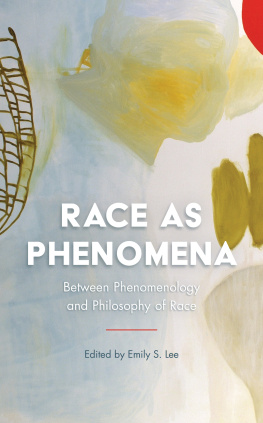RACE AND THE SENSES
SENSORY STUDIES SERIES
Series Editor: David Howes
As the leading publisher of scholarship on the culture of the senses, we are delighted to present this series of cutting-edge case studies, syntheses and translations in the emergent field of sensory studies. Building on the success of the Sensory Formations series, this new venture provides an invaluable resource for those involved in researching and teaching courses on the senses as subjects of study and means of inquiry. Embracing the insights of a wide array of humanities and social science disciplines, the field of sensory studies has emerged as the most comprehensive and dynamic framework yet for making sense of human experience. The series offers something for every disciplinary taste and sensory inclination.
Race and the Senses
The Felt Politics of Racial Embodiment
SACHI SEKIMOTO AND CHRISTOPHER BROWN
First published 2020 by Bloomsbury Academic
Published 2020 by Routledge
2 Park Square, Milton Park, Abingdon, Oxon OX14 4RN
605 Third Avenue, New York, NY 10017
Routledge is an imprint of the Taylor & Francis Group, an informa business
Copyright Sachi Sekimoto and Christopher Brown, 2020
Sachi Sekimoto and Christopher Brown have asserted their right under the Copyright, Designs and Patents Act, 1988, to be identified as Authors of this work.
For legal purposes the Acknowledgments on p. viii constitute an extension of this copyright page.
Cover design: Ben Anslow
Cover image: Bird Feather ( Simon Gakhar/Getty Images)
All rights reserved. No part of this book may be reprinted or reproduced or utilised in any form or by any electronic, mechanical, or other means, now known or hereafter invented, including photocopying and recording, or in any information storage or retrieval system, without permission in writing from the publishers.
Notice:
Product or corporate names may be trademarks or registered trademarks, and are used only for identification and explanation without intent to infringe.
A catalogue record for this book is available from the British Library.
A catalog record for this book is available from the Library of Congress.
Series: Sensory Studies Series
Typeset by Deanta Global Publishing Services, Chennai, India
ISBN 13: 978-1-3500-8753-8 (hbk)
For Taisei
Our sensory delight
We thank our family and friends in Japan and the United States who nurtured us throughout the process of writing this book. We appreciate the continued support from our parents, Kazue and Toshiro Sekimoto, and Louise and Hooker Brown. This book project evolved through many conversations with our friends and colleagues, including Kathryn Sorrells, John (Jack) Condon, Kyoko Kataoka, Takahiro Yamamoto, Godfried Asante, Shinsuke Eguchi, Yusaku Yajima, Osei Appiah, Timothy Berry, and Karma Chvez. We also thank Sarah Olson for writing an article on our book for the university magazine.
We developed and wrote the bulk of this book during our sabbatical leave in Japan in 201718. We thank our colleagues in the Department of Communication Studies and Dean Matthew Cecil for institutional and academic support for completing this book. We are deeply indebted to Tetsuya Kono at Rikkyo University in Tokyo and Chie Torigoe at Seinan Gakuin University in Fukuoka for hosting us as visiting scholars in Japan. We were able to develop our chapters by presenting at various academic outlets, including a workshop at SIETAR Japan, various symposiums organized by researchers in the Face-Body Studies, and seminars at Rikkyo University and Seinan Gakuin University. We also thank the Rhetoric, Media and Social Change Speaker Series at Drake University for giving us the opportunity to present our work. Outside of academic support, Keiko Kitagawa, Natsumi Nigawara, Ikuko Tashiro, Makiko Otaki, and Norikazu Otaki shared invaluable friendship during our stay in Japan.
We thank undergraduate and graduate students in Advanced Intercultural Communication and Race and Communication for their insights and feedback. Special thanks to Katie Olson for sharing our excitement for the book and assisting us by proofreading the manuscript. The original version of were published in Critical Philosophy of Race in 2018. We thank the editors and reviewers of these journals for helping us pave the path toward this book project.
We thank David Howes, the series editor, for the opportunity to explore our inquiry on race and the senses on our terms and in our creative and intellectual capacity. We also thank the anonymous reviewers for their suggestions and feedback. We are grateful for the incredible editorial and production team at Bloomsbury Academic for their support and dedication, including Miriam Cantwell, Lucy Carroll, Lily McMahon, Angelique Neumann, and Rennie Alphonsa.
Our deepest appreciation goes to our son, Taisei, for shining our way forward and giving us the reason to embrace our senses fully.
1
Introduction
Feeling Race
Race and the Senses elaborates on the following argument: race is felt and sensed into being. Multiple senses are engaged to feel race and racial differences, and such embodied multisensory feelings are integral to the social, political, and ideological construction of race. We wrote this book as a form of sensorium infused with racial meanings and racialized ways of feeling. That is, the senses are both the object of our investigation and the means of our inquiry. Grounded in the authors bodily and sensorial experiences as a Japanese woman living in the United States (Sachi) and an African American man from Chicago (Chris), each chapter explores the lived sensations of racism and racialization by investigating how race appeals to and is entangled with our lived and sensorial embodiment. As coauthors and life partners, we explore the world of race as a multisensorial event, paying attention to how race is constructed, reproduced, and experienced feelingly through our sensory perceptions, affective engagements, and embodied experiences.
Our inquiry into the relationships between race and the senses are driven by two primary purposes. First, while race as a visual construct has long informed and shaped the public and scholarly discussions on race, this book expands the scope of racial theorizing by attending to the multisensory dimensions of race, racialization, and racism. The visual dimension of racial experience is pervasive and undeniable: race functions as a visual economy of difference in which visible phenotypes are coded into hierarchical social relations. Visual perception of race, however, is always intertwined with other sensory, affective, and emotional experiences. Not only do we see race, we interact with its various sensations somatically. We explore how race is not only seen but also felt and registered through multiple and intertwined senses and sensations. Second, we explore the possibility of using embodied experiences and bodily sensations as a source of knowledge. The lived body is both an affective medium of subjective experience and a site where power relations and ideological norms are habituated. We examine bodily sensations and visceral feelings to reveal and problematize how social norms, values, and relations of power are habituated and materialized into lived embodiment.











